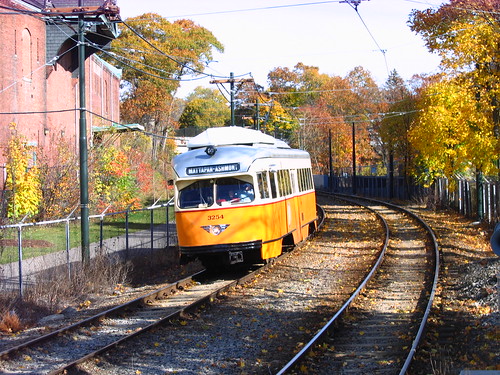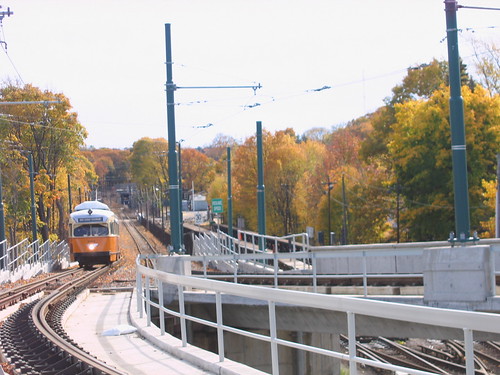Running 2.6 miles from Ashmont to Mattapan, south of Boston, the Mattapan High Speed Line acts as an extension of the Red Line subway. But it is unique in America as the last "native" operation of PCC Streetcars. I had the privilege to ride the line at Railvolution Boston a few weeks ago.

A car bound for Mattapan approaches Milton station
These streetcars are named after the "Presidents' Coordinating Committee" of the leaders of streetcar companies to save the streetcar from competition. Their 1929 endeavour created what is perhaps the most endearing symbol of transit in the inter-war and post-war era. The first PCC cars were delivered to Pittsburgh in 1936, and almost every American city operated the cars into the 1950s. Several cities continued to operate major fleets into the 1970s, when LRV conversion began in earnest.
The Mattapan Line opened in 1929 using an abandoned railroad route. Over time, streetcars became less and less prevalent in Boston and in the United States as lines were bustituted and abandoned. But the Mattapan line was retained. One reason that line rail was not converted to bus was because it used a private right-of-way. Similar situations kept lines in San Francisco, Pittsburgh, and other cities from being bustituted as well. While many PCC lines have been upgraded to modern LRV operation, including other lines in Boston, Mattapan's bridge weight limits have kept PCCs running out of Ashmont.

A PCC approaches the new terminal loop at Ashmont
While many cities have brought back PCC cars as touristy or heritage-type lines, Boston's Mattapan line is unique in that service has been more or less continuous except for a two-year closure for rebuilding from 2006-2008. Pittsburgh used PCC cars in regular service until 1999 and Newark suspended use of PCCs in 2001, leaving Boston's the last surviving continuous PCC operation.

A train at Central Avenue
The cars used on the Mattapan Line, therefore, are some of the oldest in revenue service in the United States, having been built between 1943 and 1946. Their recent rebuilding has put them in excellent shape, however. Trips on the train are smooth and quick. And for a railfan, quite thrilling, too.
The line's name is a bit misleading. Trains only travel at an average speed of around 20mph between Ashmont and Mattapan. However, the line has only two grade crossings, and as an extension of the Red Line, is effective. It makes the trip from Ashmont to Mattapan in only 9 minutes.










6 comments:
Matt,
Did they do anything to the cars themselves while the line was closed?
I rode on this line in the late 90s, and I thought all but one were green.
Also, I remember a couple of streetcars in one of the Green Line underground stations. One PCC and one older car.
@kenf,
All the cars were rehabbed during the closure. They now wear the orange/white paint scheme you see in the photos. Apparently, this is more true to their roots.
There is still one PCC and one older car parked in the Boylston Station on the Green Line. They are kept on the track adajcent to the Inbound track, and are easily visible from the Inbound platform or trains on either track.
Don't forget that in Boston, the Silver Line was used as a supposed substitute for rail, at least on Washington St. That was after the Orange Line relocated in 1987. The MBTA has been trying to ram through BRT on the Silver Lie and the Urban Ring, but it went nowhere, especially with attempts to raze an LRT tunnel branching from the Green Line that hasn't been used since the 1960s. (That tunnel branches from Boylston.)
I really don't think BRT should be used as a substitute for rail; this is apparent here in Ottawa, brought up when they say, "Look! Let's all use BRT as an alternative to rail!" But there is a role in which BRT and LRT can be complementary rather than competing. This is true even when they promise BRT can be converted to rail, but only at the expense of a closure and a large monetary expense, which will be likely here in Ottawa.
The situation in Ottawa with the Transitway, by the way, is similar to after Pittsburgh built the busways in the sense of paving over a former rail line.
"last "native" operation of PCC Streetcars."
What about the 15 Girard line in Philly? http://en.wikipedia.org/wiki/SEPTA_Route_15
@kenf,
I think the decade-long suspension of service (bustitution) would disqualify it. Feel free to disagree.
And while Mattapan was suspended for two years, it was only suspended for rebuilding and rehabilitation, not as an excuse to get rid of streetcars.
Post a Comment